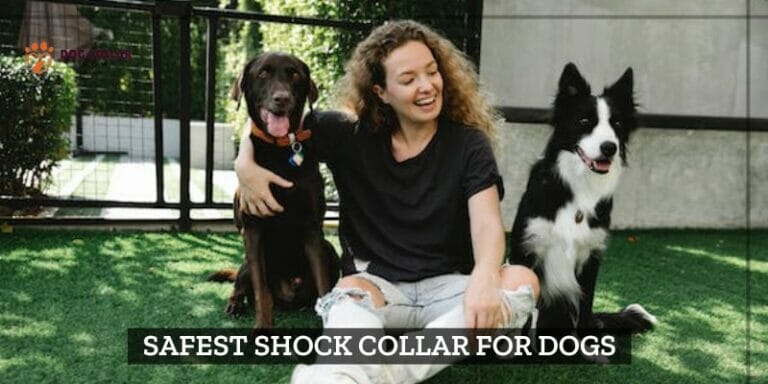Why Are Dogs Scared Of Shock Collars – Main Reasons

Ever wondered why some dogs become fearful or anxious around shock collars? It’s a question that delves into the intricate relationship between our canine companions and the training tools we use.
Dogs can become scared of shock collars due to the association of pain or discomfort with these devices, leading to fear and anxiety during training.
In this exploration, I’ll unravel the psychological and behavioral factors contributing to a dog’s aversion to shock collars and explore more compassionate training alternatives.
Why Are Dogs Scared Of Shock Collars – Reasons
As a devoted pet parent, I’ve explored the reasons why some dogs become scared of shock collars. It’s crucial to understand our furry friends’ perspectives, right?
Negative Physical Reactions To Shock Collars:
- Discomfort And Pain: The primary reason behind dogs’ fear of shock collars lies in the discomfort and pain they can inflict.
These collars administer electric shocks, even at lower settings, which can range from mildly uncomfortable to outright painful for our furry companions.
Just as we would find an unexpected jolt distressing, dogs can associate this physical discomfort directly with the electronic collar itself.
- Varied Sensitivity: It’s essential to recognize that dogs have varying pain thresholds and sensitivity levels. What might be a tolerable sensation for one dog can be excruciating for another.
This individual variation can lead to differing reactions, but the common thread is that the experience is aversive.
- Unpredictable Discomfort: The unpredictability of when the shock might occur adds another layer of anxiety. Dogs cannot anticipate when they’ll receive a shock, which can keep them on edge during training sessions, not knowing when the discomfort might strike.
- Associative Learning: Dogs excel at associative learning. If the shock collar becomes consistently linked to this discomfort during training, it can quickly form negative associations. Over time, they come to dread the sight of the collar and training sessions in general.
- Counterproductive Responses: Interestingly, some dogs respond to the discomfort caused by the shock collar with counterproductive behaviors. Instead of learning the desired behavior, they may become anxious, fearful, or even agitated, hindering the training process.
Negative Emotional Reactions To Shock Collars:
- Anxiety And Stress: Shock collars can trigger anxiety and stress in dogs during training sessions. The anticipation of the discomfort or shock can create a persistent sense of unease and nervousness, making training an emotionally distressing experience.
- Fear And Apprehension: Dogs are highly perceptive and can quickly associate the shock collar with fear-inducing experiences. This fear can extend to the sight of the collar itself and even to the training environment, making them apprehensive.
- Trust Erosion: Building and maintaining trust between a dog and their owner is paramount for effective training and a healthy bond.
When shock collars are used, especially without proper positive reinforcement, dogs can begin to view their owners as sources of discomfort and become wary or mistrustful.
- Replacing Positivity With Uncertainty: Positive interactions, treats, and praise are essential components of effective training that dogs thrive on.
Shock collars replace these positive associations with uncertainty, fear, and unpredictability, hindering the dog’s willingness to engage in the training process.
- Avoidance Behavior: Some dogs develop avoidance behavior when they associate shock collars with fear and anxiety.
They may try to escape or hide when they see the collar or sense training time approaching, further complicating the training process.
- Detrimental To Learning: Fear and anxiety can impede a dog’s ability to learn effectively. When dogs are preoccupied with their emotional state, they may struggle to focus on the training task at hand, hindering progress.
Understanding these physical and emotional factors is crucial for responsible pet ownership. It reminds us to prioritize our dogs’ well-being and seek training techniques that build trust and confidence rather than instilling fear.
Ways To Desensitize Dogs To The Shock Collar
Here are some ways to desensitize dogs to the shock collar:
- Begin by letting your dog associate the presence of the collar with positive experiences. Offer treats, praise, and playtime when you introduce the collar. This helps create a more positive perception.
- Initially, keep the collar turned off. Allow your dog to wear it without experiencing any shocks. This helps them get used to the sensation of wearing it without any discomfort.
- When you do decide to use the collar for training, start with the lowest possible setting. The sensation should be minimal and not painful. This gradual introduction minimizes fear.
- Associate the stimulation with specific commands. For example, if you’re using the collar to stop unwanted behavior, ensure the dog understands the command associated with the correction.
- Pay close attention to your dog’s reactions. If they exhibit signs of distress or fear, such as cowering or whining, it’s crucial to stop and reassess your approach.
- Keep training sessions short and positive. Avoid prolonged or repetitive use of the collar, as this can lead to fear and anxiety.
- Be consistent with your commands and the timing of the stimulation. This helps your dog understand the cause-and-effect relationship, reducing confusion and fear.
- Always follow any stimulation with positive reinforcement. When your dog responds correctly to the command, reward them with treats, praise, and affection.
- If you’re uncertain about using a shock collar, consider seeking guidance from a professional dog trainer. They can provide expert advice and ensure safe and effective training.
- Remember that every dog is unique. Some may never respond well to shock collars, while others may adapt. Always prioritize your dog’s comfort and well-being in training.
Desensitizing your dog to a shock collar should be a gradual and positive process. The goal is to build trust and understanding, ensuring that your dog associates the collar with effective training rather than fear or discomfort.
Common Misconceptions About Shock Collars
- They Are Harmless: One of the most prevalent misconceptions is that shock collars are entirely harmless. While some proponents argue they’re safe when used correctly, there’s a wide range of sensitivities among dogs, and what’s mild for one can be painful for another.
- Effective for All Dogs: Shock collars are not universally effective. Dogs have different temperaments and learning styles, and some may not respond well to this form of training. It’s not a one-size-fits-all solution.
- Quick Fix for Behavioral Issues: Many people believe that shock collars provide quick fixes for behavioral problems. However, they often address symptoms rather than underlying issues and can lead to increased anxiety or aggression.
- They Don’t Hurt: While proponents argue that shock collars are merely “stimulating” or “uncomfortable,” they can indeed cause pain and distress, especially in higher settings or for sensitive dogs.
- They’re the Only Option: Some believe that shock collars are the only way to control a dog’s behavior. In reality, positive reinforcement training techniques have been proven to be equally effective without causing fear or anxiety.
- Consistency in Training: Shock collars are sometimes seen as a way to ensure consistent training. However, consistency can be achieved through other humane methods, such as treats and praise.
- Only Used For Aggressive Dogs: Shock collars are not exclusive to aggressive dogs. They’re often used for various training, including obedience and containment, but they can have negative consequences if misused.
- Long-Term Solution: Shock collars are sometimes perceived as long-term solutions to behavior problems. However, they should ideally be used sparingly and in conjunction with positive reinforcement techniques for lasting results.
- No Psychological Impact: Shock collars can have a significant psychological impact on dogs, leading to fear, anxiety, and a breakdown of trust between the pet and owner.
- Appropriate for All Situations: Shock collars may not be suitable for all situations, such as recall training or addressing fear-based behaviors. Understanding when and how to use them is crucial.
These misconceptions highlight the importance of thoroughly researching and considering alternative, humane training techniques to ensure the well-being and happiness of our canine companions.
What Is A Better Alternative To Using A Shock Collar?
A better alternative to using a shock collar is positive reinforcement training. This approach focuses on rewarding and reinforcing desired behaviors rather than punishing unwanted ones. Here’s why it’s a superior choice:
1. Promotes Trust And Bonding: Positive reinforcement strengthens the bond between you and your dog by creating a positive and trusting training environment. Your dog associates good behavior with your approval and rewards, building a stronger connection.
2. Effective And Long-Lasting: Studies have shown that positive reinforcement is highly effective and leads to long-lasting behavioral changes. Dogs learn to repeat behaviors that result in rewards, making training more sustainable.
3. No Fear Or Pain: Unlike shock collars, positive reinforcement does not involve causing fear, pain, or distress to your dog. It’s a humane and gentle approach that ensures your dog’s emotional well-being.
4. Versatile And Adaptable: Positive reinforcement can be used for a wide range of training purposes, from basic obedience to addressing complex behavioral issues. It’s a versatile approach that can be adapted to your dog’s specific needs.
5. Encourages Problem-Solving: Dogs trained using positive reinforcement often become better problem solvers. They learn to think and make choices, which enhances their mental stimulation and overall intelligence.
6. Consistency And Predictability: Positive reinforcement provides consistent and predictable consequences for your dog’s actions. This clarity helps dogs understand what’s expected of them and reduces confusion.
7. Builds Confidence: Dogs trained with positive reinforcement tend to be more confident and less anxious. They learn that they have control over their environment through their actions, boosting their self-assurance.
8. Suitable For All Dogs: Positive reinforcement can be used with dogs of all ages, breeds, and temperaments. It’s a universal training approach that respects and accommodates individual differences.
Positive reinforcement training offers a humane, effective, and rewarding alternative to shock collars. It not only achieves the desired behavior but also creates a happier, more confident, and more trusting relationship between you and your beloved canine companion.
Conclusion
Dogs become scared of shock collars due to the combination of negative physical sensations and emotional distress they experience during training. This fear can undermine trust, hinder the training process, and even damage the bond between dogs and their loving pet parents. Understanding these concerns highlights the importance of exploring alternative, more humane training methods that prioritize our dogs’ emotional well-being and comfort.
FAQs
How does the training method using shock collars work?
Shock collars work by delivering an electric shock to the dog’s neck when triggered. This is intended to discourage undesirable behaviors and reinforce desired behaviors.
Can shock collars be used to train your dog?
Yes, shock collars can be used as a training tool. However, it is important to use them responsibly and under the guidance of a professional dog trainer.
Can shock collars be used to solve barking issues?
Shock collars can be used to discourage excessive barking, but it is important to address the underlying cause of the barking behavior and use other training techniques alongside the collar, if deemed necessary.
What are the potential consequences of using shock collars on dogs?
The use of shock collars can cause dogs to become fearful, anxious, or aggressive. It may also damage the bond between the dog and the owner and lead to a breakdown in trust.






